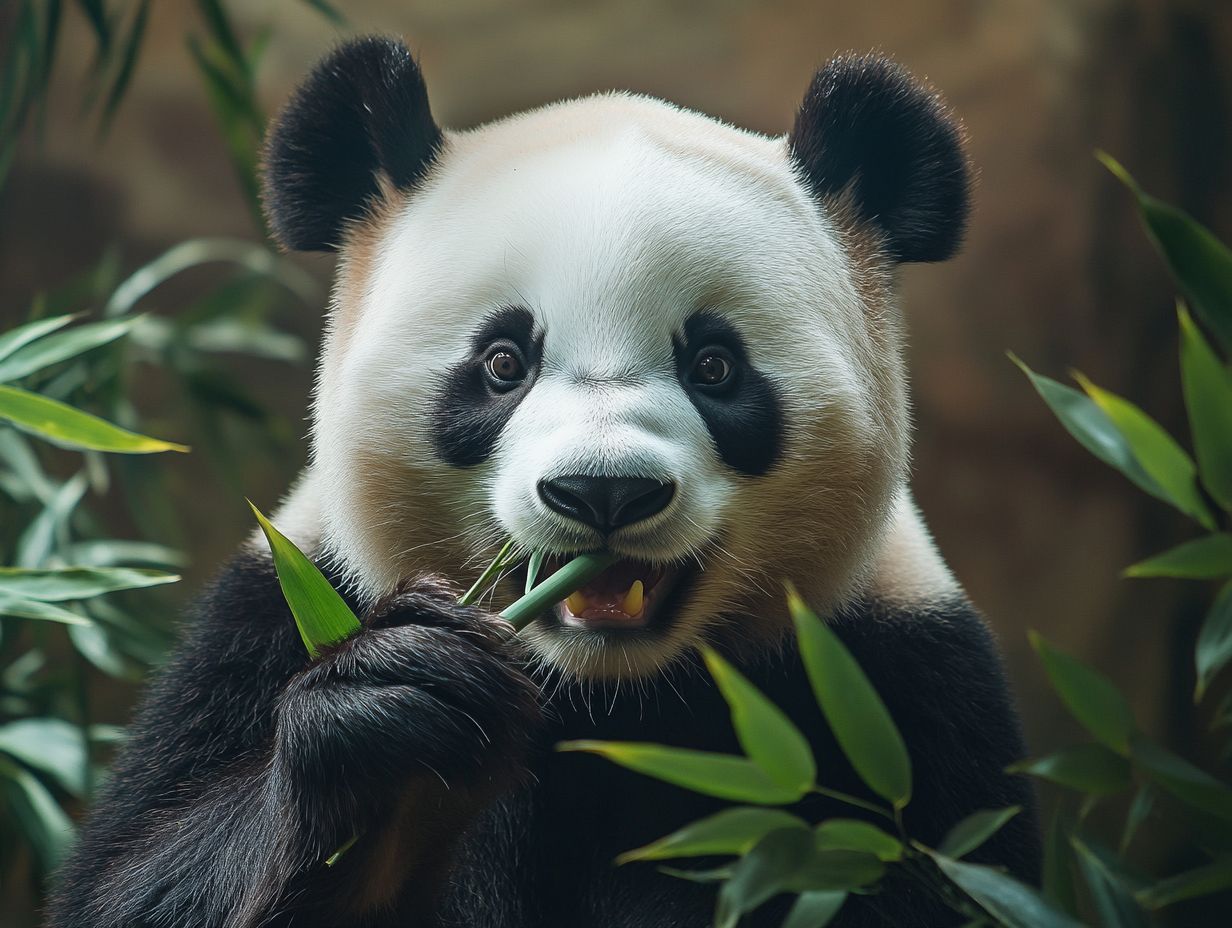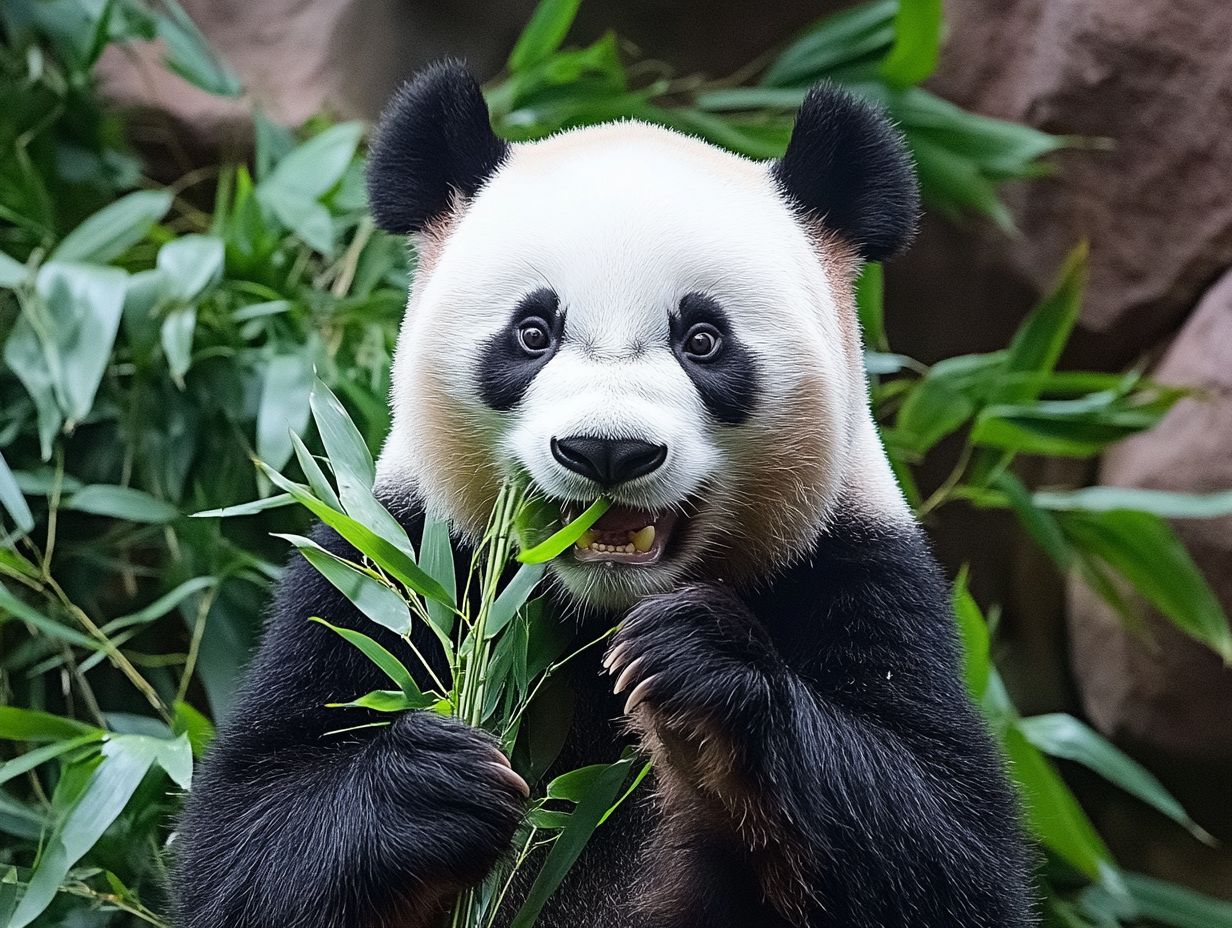Pandas are not merely adorable creatures; their unique dietary habits present an equally captivating aspect of their existence. Primarily reliant on bamboo, these gentle giants consume vast quantities each day, rendering them intriguing subjects for scholarly observation.
Here are five fascinating facts about the panda diet, ranging from their essential bamboo intake to the dietary preferences of baby pandas. Additionally, the occasional food choices they make and the seasonal shifts in their eating habits warrant discussion.
This exploration reveals the wonders of the pandas’ nutritional practices and underscores the significance of such understanding in the broader context of their conservation and well-being.
Key Takeaways:

- The panda’s primary diet consists of bamboo, which is essential for their survival.
- Pandas occasionally diversify their diet with other foods, such as fruits and insects, to meet their nutritional needs.
- Baby pandas have a specialized diet that includes their mother’s milk and later on, bamboo shoots.
Pandas Primarily Eat Bamboo
Bamboo stands as the cornerstone of the panda diet, offering essential nutrients and a vital source of energy while significantly influencing their distinctive feeding habits and behaviors. These remarkable creatures demonstrate their adaptability by consuming a variety of bamboo species, underscoring both their dependence on this resource and the ecological importance of bamboo forests within their natural habitats.
Why Bamboo is Essential for Pandas
Bamboo is essential for pandas, serving as their primary food source that fulfills both their nutritional and energy requirements crucial for survival.
This remarkable plant is rich in vital components such as carbohydrates, fiber, and protein, all of which are integral to maintaining the health of both wild and captive pandas. The high fiber content assists in digestion, while the carbohydrates offer the necessary energy for them to thrive in their natural environments.
The availability of bamboo is intricately linked to conservation efforts, as habitat loss and climate change pose significant threats to these vital resources. As bamboo forests decline, so too do panda populations, highlighting the urgent need to preserve these ecosystems to ensure the longevity of these cherished creatures.
Types of Bamboo Consumed
Pandas exhibit a remarkable dietary preference, consuming various types of bamboo, including black bamboo and water bamboo, each offering distinct nutritional benefits tailored to their needs.
These species are critical for a panda’s diet, delivering essential nutrients such as protein, calcium, and fiber that are vital for maintaining their health. The seasonal availability of bamboo introduces an intriguing dynamic, with certain species flourishing during warmer months while others thrive in cooler climates, ensuring a varied food source throughout the year.
The ecological diversity of bamboo forests in China is pivotal not only for sustaining pandas but also for supporting a wide array of other wildlife. These forests serve as habitats for numerous species, enriching the intricate tapestry of biodiversity that defines these unique ecosystems.
Dietary Diversification
Although bamboo forms the cornerstone of a panda’s diet, these remarkable creatures are omnivores, occasionally indulging in a diverse array of other foods to fulfill their nutritional requirements.
Occasional Foods Beyond Bamboo

Plus bamboo, pandas relish a selection of occasional treats, including apples and specially crafted panda cakes, which offer essential nutrients and diversity in their diets.
These supplementary foods are vital for enriching their nutritional intake, introducing vitamins and minerals that may be scarce in a bamboo-only diet. For example, the inclusion of fruits such as apples enhances their consumption of dietary fiber and antioxidants, thereby promoting overall health.
Furthermore, integrating these delightful morsels into enrichment programs not only stimulates their natural foraging instincts but also fosters physical activity, a key element in maintaining a healthy weight.
By incorporating a variety of foods, caregivers can effectively replicate the diverse eating habits pandas would naturally exhibit in the wild, thereby supporting their well-being and improving their quality of life in captivity.
Feeding Habits
Pandas display distinctive feeding habits, engaging in extensive foraging for bamboo that consumes a considerable portion of their day.
To sustain their energy requirements, they must consume substantial quantities of this plant daily.
Daily Eating Routine
Pandas typically dedicate around 10 to 16 hours each day to foraging and eating, underscoring their substantial need for bamboo to fulfill their nutritional requirements.
In fact, these gentle giants can consume up to 28 pounds of bamboo daily—approximately 12.7 kilograms. This impressive intake is essential, as bamboo is notoriously low in nutrients, necessitating their relentless grazing to meet their energy demands.
Their continuous feeding not only sustains their health but also serves a critical role in the ecosystem by fostering forest growth and stability. However, this dependence on bamboo renders them vulnerable, as habitat loss presents significant threats to their survival. Conservation efforts are therefore focused on safeguarding both their habitats and food sources, ensuring the continued existence of these iconic creatures.
Seasonal Changes in Feeding
Seasonal variations exert a profound influence on the feeding habits of pandas, impacting the availability of bamboo and consequently modifying their foraging behavior.
In the warmer months, a greater diversity of bamboo species thrives, allowing these gentle giants to enjoy a more varied diet. However, as temperatures drop and winter approaches, certain bamboo types become scarce, compelling pandas to adapt their foraging strategies.
This dependence on a diverse array of bamboo species highlights the critical importance of habitat conservation efforts aimed at preserving a stable environment for these iconic creatures. As climate change continues to alter ecosystems, safeguarding these habitats becomes essential to ensure pandas have access to the varied food sources necessary for their survival and health, ultimately affecting their reproductive success.
Baby Pandas’ Diet
The diet of baby pandas, known as pandacubs, commences with essential breastmilk, crucial for their growth and development. As they mature, this diet gradually transitions to bamboo, their primary source of nourishment.
What Do Baby Pandas Eat?

In their early stages, baby pandas depend entirely on their mother’s milk, which serves as a complete source of essential nutrients until they transition to bamboo around six months of age. This initial diet is vital for their development, promoting strong bones and a robust immune system, as the milk is rich in crucial proteins and fats.
As these young pandas mature, they gradually begin to venture into their surroundings and sample the fibrous shoots and leaves of bamboo, marking a significant evolution in their dietary requirements. The mother plays a pivotal role in this transition, guiding them in selecting the appropriate types of bamboo and imparting the necessary skills to chew and digest this fibrous sustenance.
This natural progression not only fosters their growth but also cultivates important foraging behaviors that will be essential for their survival in the wild.
Also Read: The Panda-Inspired Guide to Growing and Using Bamboo in Your Backyard
Drinking Habits
Pandas exhibit distinctive drinking habits, primarily deriving moisture from the bamboo they consume. However, they also engage in drinking water to maintain proper hydration levels.
What Do Pandas Drink?
Plus their primary diet of bamboo, pandas require fresh water, which plays a crucial role in their overall health and hydration. In the wild, these remarkable creatures often source their water from mountain streams, rainfall, and natural puddles that form within their forest habitats, allowing them to maintain adequate hydration levels.
In captivity, pandas benefit from access to clean, filtered water within their enclosures, effectively mimicking their natural environment. This proper hydration not only supports their physical fitness but also aids in the digestion of their bamboo-heavy diet. The connection between water availability and nutritional health is paramount, as it underpins their metabolic processes and overall well-being, ensuring that they remain active and thrive, whether in the wild or in controlled settings.
FAQs About Panda Diet
Numerous inquiries emerge regarding the panda diet, particularly concerning the kinds of food they consume and their nutritional requirements.
While it is a common misconception that these iconic bears, known scientifically as Ailuropoda melanoleuca, subsist solely on bamboo, the reality is far more intricate. Bamboo does indeed make up approximately 99% of their diet; however, giant pandas occasionally enhance their meals with other vegetation, fruits like apples, and even small animals such as pikas when bamboo becomes scarce. Their distinctive digestive system, specially adapted for processing plant material, presents challenges in nutrient absorption, which explains why they consume an astonishing quantity of bamboo each day.
Grasping the complexities of their dietary habits and eating habits not only helps to dispel prevalent myths but also underscores the critical importance of habitat preservation and understanding environmental changes in the broader context of panda conservation efforts at places like the San Diego Zoo and in China.
Frequently Asked Questions
What Pandas Eat: 5 Fascinating Facts About the Panda Diet

1. What do pandas primarily eat?
Pandas are known for their love of bamboo, which makes up 99% of their diet. They consume an impressive 26 to 84 pounds of bamboo per day, including varieties such as black bamboo and water bamboo!
2. Do pandas ever eat anything besides bamboo?
While bamboo is their main source of food, pandas have been known to occasionally supplement their diet with small rodents, birds, carrion, and other vegetation like mushrooms, corn bread, and even panda cakes.
3. Why do pandas eat so much bamboo?
Bamboo is a low-nutrient food, so pandas have to eat large quantities in order to get enough energy to satisfy their dietary needs. It also has a low digestibility rate, meaning they have to eat even more to meet their energy needs.
4. How do pandas eat bamboo?
Pandas have a specialized wrist bone that helps them grip and strip the tough outer layer of bamboo. They also have strong jaw muscles and sharp teeth to help them chew through the fibrous plant.
5. Are pandas picky eaters?
Yes, pandas are very picky when it comes to their food. They will only eat certain species of bamboo, known as bamboo species, and even within those species, they have preferences for specific parts of the plant. This pickiness is observed in both wild pandas and captive pandas.
6. Can humans benefit from eating bamboo too?
Absolutely! Bamboo is not only a sustainable and versatile material, but it also has numerous health benefits for humans. It is rich in fiber, antioxidants, and can help regulate blood sugar levels. So next time you see a panda munching on bamboo, remember that it’s not just their favorite food, but it’s also good for us too.
